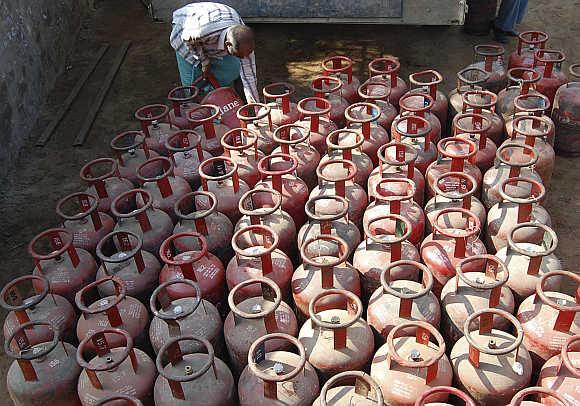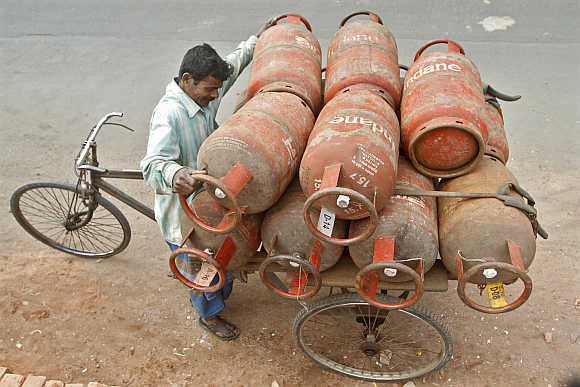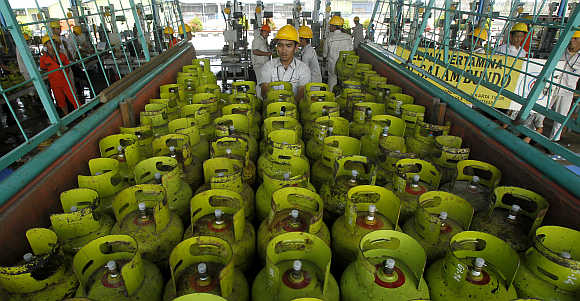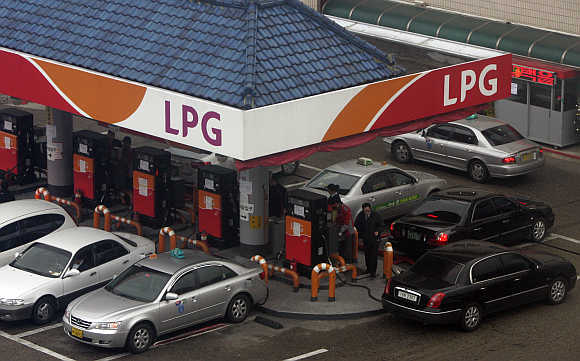
It launched a programme covering 18 of the country’s 600-odd districts to credit the subsidy (the difference between the retail and market price) on liquefied petroleum gas cylinders directly into the accounts of 6.7 million consumers with bank accounts linked to the Aadhaar (unique identification) number.
Known as the direct benefit transfer, it is part of a change that is nothing short of a revolution in the LPG economy under the United-Progressive Alliance-II government involving 140 million consumers, three oil marketing companies and some 11,500 distributors. All this has come about without much protest, agitation or the slightest rethink.
The government even took the plunge and sacrificed its alliance with the Trinamool Congress last September when it decided to put in place a quota of six subsidised cylinders instead of an unlimited number that was available to consumers till then. DBT might appear to be a simple process in which a consumer gets a credit into his bank account the moment he books a cylinder, so long it is within his quota of nine subsidised cylinders.
But it is being made possible through a complicated web of processes that is still at an experimental stage.
...

At its simplest, this is how it works. Consumers get an Aadhaar number and visit a bank branch to open an account if they do not have one. If they already have a bank account, then the Aadhaar number has to be linked with that bank account either at the branch or through a request form available with LPG distributors.
The Aadhaar number is provided to the distributors for linking it with the LPG consumer’s number. Although the penetration of Aadhaar numbers in these districts is 90 per cent, the proportion of Aadhaar numbers linked to bank accounts is just over 20 per cent and the linkage between the LPG consumer numbers and Aadhar is almost 60 per cent.
In the first month of DBT, some 1.5 million transactions involving a subsidy transfer of Rs 60.47 crore have taken place. (On July 1, Mysore district was included in the programme). It is the next stage in the slow but steady oil subsidy reform process that began in October last year that might be challenging. Customers know that anything beyond the quota will cost them Rs 750 instead of Rs 399.
Though the quota for non-subsidised cylinders was capped at nine in January this year, the introduction of a limit introduced domestic cooking gas consumers to the concept of market pricing.
...

Currently, a consumer is charged 96 per cent more for non-subsidised cylinders that are selling at Rs 802 in New Delhi, so the difference is steep. With the introduction of DBT, consumers will pay the market price for all cylinders and take the differential for nine cylinders as subsidy in their bank accounts. Such a system makes it possible for the government to have a different subsidy scale for different sets of consumers depending on their income levels.
This also creates the opportunity to close the subsidy tap for the affluent. Though the government currently has not expressed such an intention yet, as it stands today, a consumer has a choice of not availing of the subsidy on cooking gas, something that was not possible even till few years back. Besides, with Aadhaar becoming mandatory in the 18 districts from September 1 this year, some consumers might be left out of the subsidy net altogether.
DBT is not a one-off programme. In the run-up to its introduction, the government-controlled oil marketing companies launched a transparency portal that allowed customers to view the number of cylinders that were booked in their name.
...

For a year now, the transparency portals of the Indian Oil Corporation, Hindustan Petroleum and Bharat Petroleum have been acting as a safeguard against bogus bookings and the diversion of commercial purposes of the 14.2 kg cylinder meant for domestic consumption. Before the portal was launched, a “de-duplication” exercise was conducted, through which LPG connections were limited to one per individual.
Alongside came the Ministry of Petroleum and Natural Gas order that made holding more than one domestic LPG connection per household punishable. An exemption was made only for those addresses where there is more than one kitchen. The de-duplication exercise was conducted across a database of 140 million customers, and 25 million connections were found to either have the same name and address or the same address and different names.
To check multiple connections, the government asked consumers to fill up Know-Your-Customer forms by November 30, last year. In all, 6.3 million customers did not respond. They were given three months’ notice, after which their connections were blocked. This year, the government expects to save Rs 8,000 crore (Rs 80 billion) through the exercise.
The total revenue loss for oil marketing companies in selling below market price was Rs 39,558 crore (Rs 395.58 billion) last year but the full benefit of capping of subsidised cylinders will bring in savings in subsidy this year.
...

During the first six months ending January 2013 of the introduction of the cap, government-controlled oil marketing companies reported an almost two per cent drop in domestic LPG consumption, against a growth of almost seven per cent in the same period in 2011-12. In contrast, industrial LPG sales grew 12.5 per cent during September 2012-January 2013 against 5.4 per cent the previous year.
Overall LPG consumption in 2012-13 grew a mere 1.6 per cent against over seven per cent in 2011-12. This year started with companies recording a drop of 1.2 per cent in domestic LPG sales in April. From the government’s perspective, the two-point agenda of controlling subsidies and channelling it better appears well within its reach.
For this, changes have been made in how cooking gas is priced and delivered, and how subsidy is disbursed. This systemic overhaul might have caused some public inconvenience but the fact remains that the LPG distribution network is being geared up for market pricing in cooking gas. In India, that’s equivalent to a Great Leap Forward.